| Article ID | Journal | Published Year | Pages | File Type |
|---|---|---|---|---|
| 6204784 | Clinical Biomechanics | 2015 | 6 Pages |
â¢Superior biomechanical performance of newly developed lateral locking plateâ¢No advantage of conventional dorsal over lateral plating using a locking implantâ¢Sufficient stability using unicortical screws for proximal phalanx plating
BackgroundDorsal plating is commonly used in proximal phalanx fractures but it bears the risk of interfering with the extensor apparatus. In this study, dorsal and lateral plating fixation methods are compared to assess biomechanical differences using conventional 1.5Â mm non-locking plates and novel 1.3Â mm lateral locking plates.MethodsTwenty-four fresh frozen human cadaveric proximal phalanges were equally divided into four groups. An osteotomy was set at the proximal metaphyseal-diaphyseal junction and fixed with either dorsal (group A) or lateral (group B) plating using a 1.5Â mm non-locking plate, or lateral plating with a novel 1.3Â mm locking plate with bicortical (group C) or unicortical (group D) screws. The specimens were loaded in axial, dorsovolar and mediolateral direction to assess fixation stiffness followed by a cyclic destructive test in dorsovolar loading direction.FindingsAxial stiffness was highest in group D (mean 321.02, SEM 21.47Â N/mm) with a significant difference between groups D and B (PÂ =Â 0.033). Locking plates (groups C and D) were stiffer than non-locking plates under mediolateral loading (PÂ =Â 0.007), no significant differences were noted under dorsovolar loading. Furthermore, no significant differences were observed under cyclic loading to failure between any of the study groups.InterpretationNo considerable biomechanical advantage of using a conventional 1.5Â mm dorsal non-locking plate was identified over the novel 1.3Â mm lateral locking plate in the treatment of proximal phalanx fractures. Since the novel low-profile plate is less disruptive to the extensor mechanism, it should be considered as a valid alternative.
